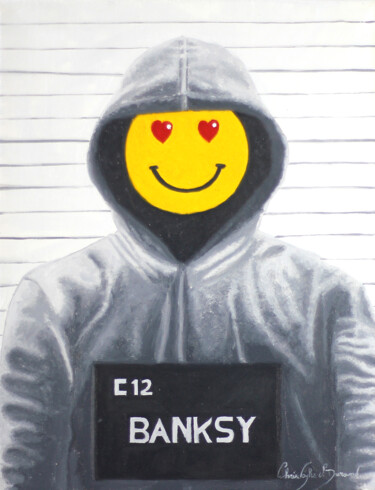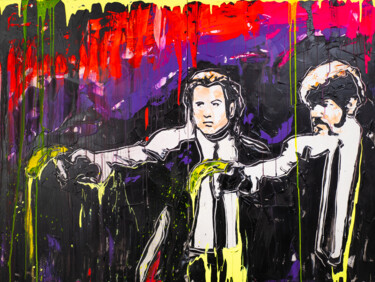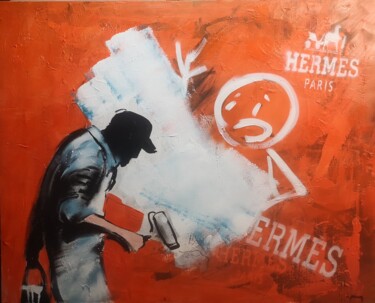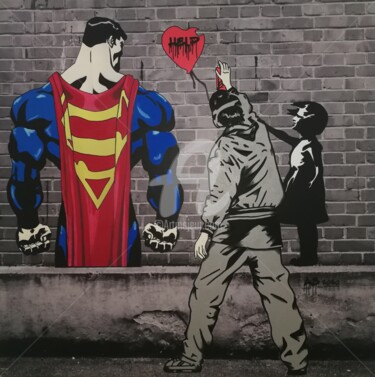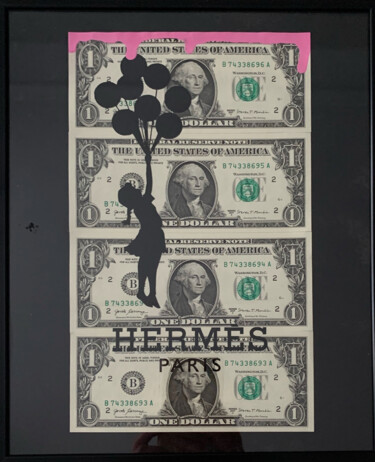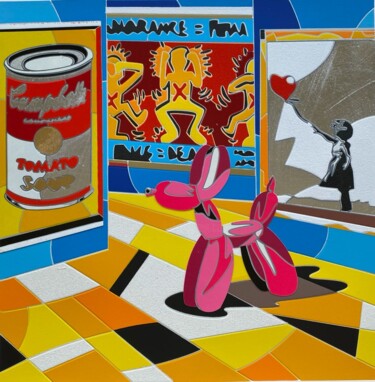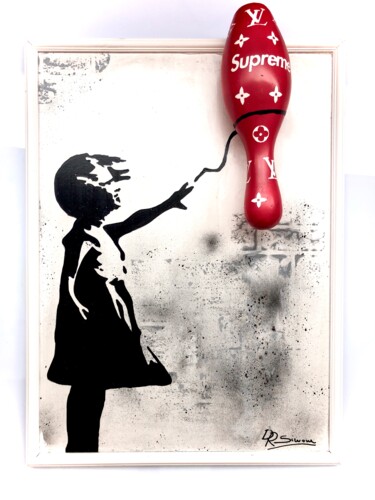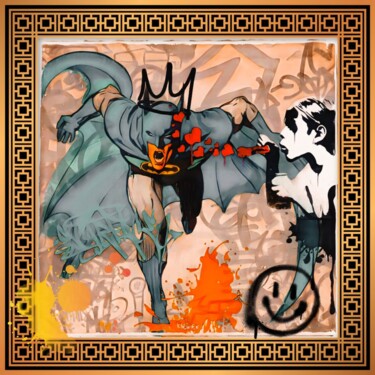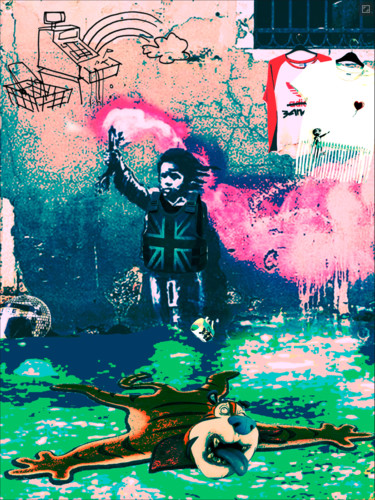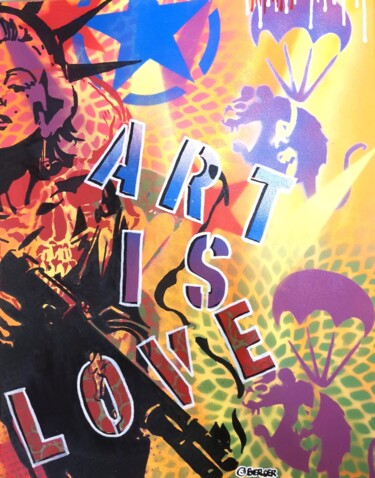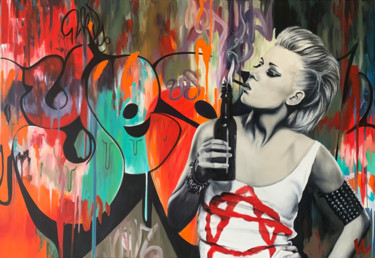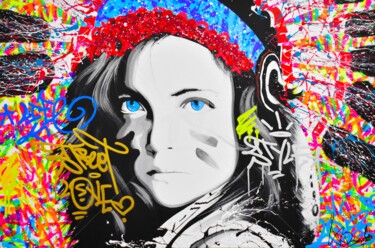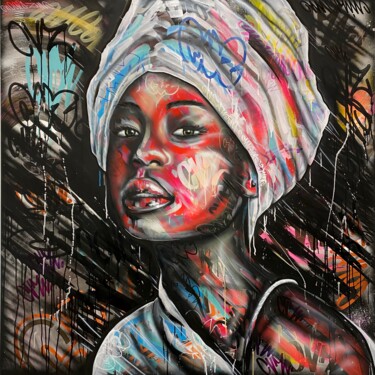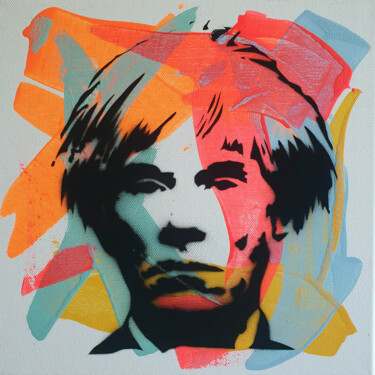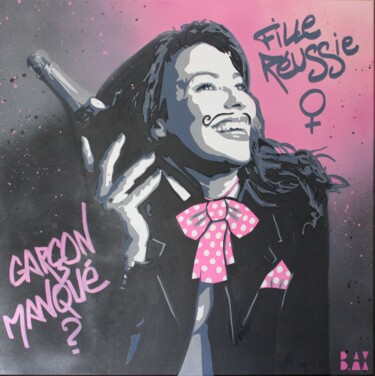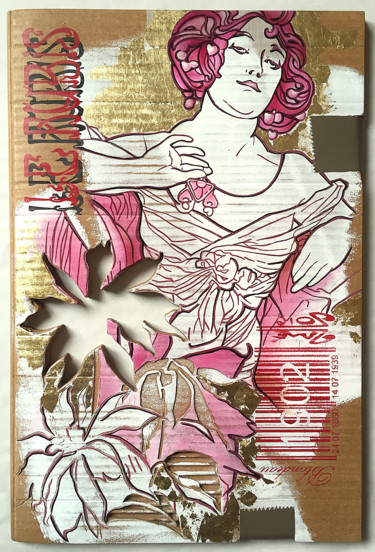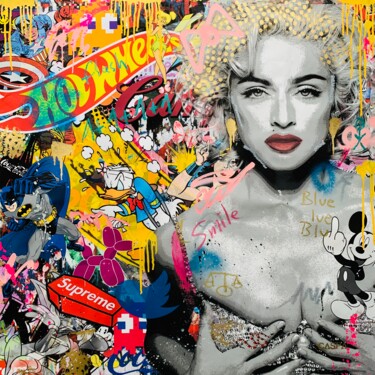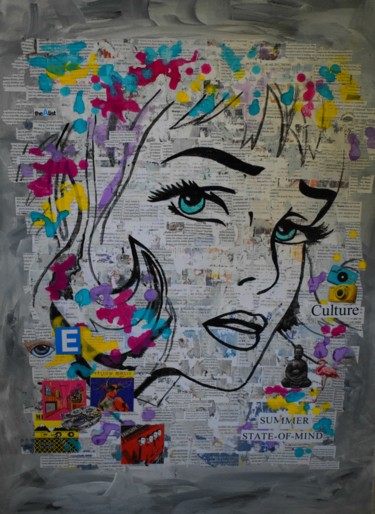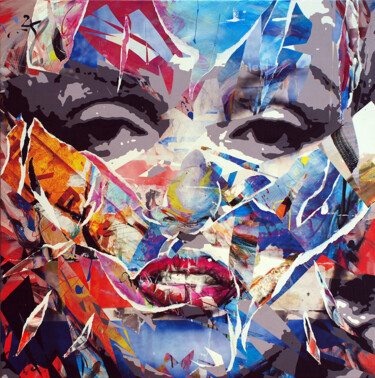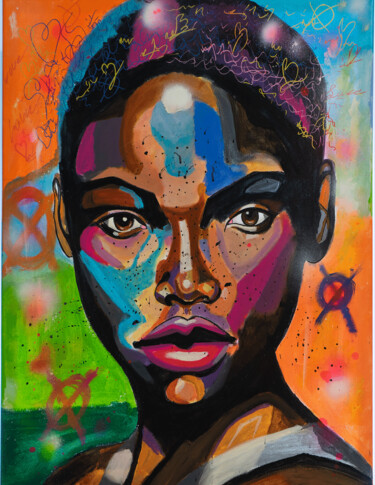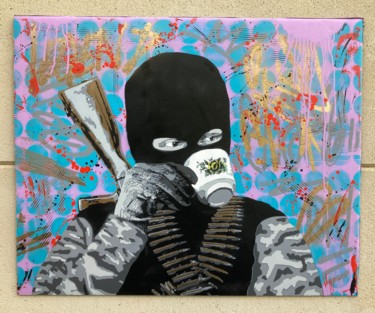 Simone De Rosa, Girl with pin by Supreme, 2021. Sculpture, acrylic / spray / wood / plastic on wood, 60 x 3 cm / 3.00 kg.
Simone De Rosa, Girl with pin by Supreme, 2021. Sculpture, acrylic / spray / wood / plastic on wood, 60 x 3 cm / 3.00 kg.
Banksy, an underground artist originally from the Bristol, UK scene, has been spreading his politicized, subversive and daring graffiti since the 1990s, although, only since 2005, has media interest become aware of the value of his point of view, made extremely fascinating also by the willingness of the "controversy artist" himself to conceal his identity, an action that seems to us to conform to the most natural attitude of superheroes: masquerading in order to be able to oppose, without limits, the evils of our society, just like a kind of Zorro equipped with a spray can. In fact, usually, the Bristol "revolutionary" has done his best to spread messages of peace, love and hope, opposing the horrors of wars, anti-liberal institutions, injustices, capitalism, etc. A question arises at this point: surely this artist's message pursues these good intentions, but are we really sure that capitalism is fought through the transformation of street art into a mainstream product? Probably, this was not the initial intent of our spray can-equipped champion, although, in any case, media attention is now focused on him, a rebellious son of more traditional consumerism, whose artistic investigation has become popular subject of commercial remakes, soap opera twists and fruitful newspaper articles. In this context, it is possible to compare Banksy's popularity with the "privacy," also due to historical periods before the advent of consumerism, of some of the greatest masters of our time, but how? Through a figurative comparison based primarily on the investigation of related themes. Such a comparison, which follows a chronological order, begins by considering the peculiarities of A Little Dancer of Fourteen (c. 1878-81)by Edgar Degas, a sculpture that exists in twenty-six examples, among which, the original version, directly made by the French master, can be considered to be the one executed in wax, now kept at the National Gallery of Art in Washington, since, the well-known versions in the Musée d'Orsay, the Metropolitan Museum of Art in New York, etc., turn out to be bronze "remakes" of the aforementioned one. The masterpiece in question depicts a dancer standing with her arms behind her back, having her right leg placed before her left leg, while her young face is turned upward. Just like Banksy's much-discussed works, the Little Ballerina caused quite a stir at the time, causing quite a stir in that, in addition to drastically departing from the idealized nudes of traditional classical French sculpture, it was made of unconventional materials, resulting in an ungraceful pose, enhanced by unconventional real accessories. Having reached this point in the description of the sculpture, it is fair to ask: what does the Bristol-based artist have to do with all this? Banksy, precisely in 2007, created Ballerina with Action Man Parts, a sculpture that, by subject matter, appears to be an update of the aforementioned French version, in that, the young girl depicted by the most famous living street artist appears to have donned a gas mask in order to denounce the most current man-made ecological disasters.
 B-Lec, The Banksy flower thrower, 2021. Acrylic on Fabric, 80 x 80 cm.
B-Lec, The Banksy flower thrower, 2021. Acrylic on Fabric, 80 x 80 cm.
On the other hand, with regard to the theme of love, one of the most popular in the history of art, it seems necessary to mention a little-known work by Edvard Munch, namely Eyes in the Eyes (ca. 1899-1900), a composition that, reduced to the smallest possible number of depicted subjects, presents its focus in the two figures of lovers arranged in a foreground, who, almost perfectly symmetrical, leave behind them a desolate landscape, dominated by the figure of a sturdy tree and a small house in the distance. In such a context, the two lovers probably do not even remember where they are anymore, so much so that they are caught up in looking intensely into each other's eyes, although, given the absence of their mouths, their "visual exchange" turns out to be necessarily silent. If we were to set this scene in modern times, the gaze of the two loved ones would surely be distracted by the multiple sensory stimuli we receive every day, as if in a kind of bombardment that, between computers and television, has now taken the prevalent form of the smartphone. This "digital" portrait of contemporary society, as well as of its interpersonal relationships, took shape in Banksy's Mobile lovers, a graffito that appeared in 2014 on a door placed inside a stone wall in Clement Street (Bristol), which, after being removed from its original support to be placed inside a more appropriate city museum, was sold, in agreement with the artist himself and for the extraordinary sum of five hundred thousand euros, in order to fund the Broad Plain Boy Club, a club for boys in Bristol, which was experiencing serious economic difficulties. Therefore, on this occasion, the juxtaposition of past masters and present artists was functional in order to reveal how Banksy, besides being a veteran of street art, is also an undisputed master of solidarity. Finally, comparing the popular artist with the iconic sculptor Auguste Rodin, author of an inescapable masterpiece of art history, The Thinker, is a must. The latter bronze sculpture, cast in 1902 from a plaster model circa 1880, depicts a man seated on a pedestal, having his torso tilted forward, while his face finds support on his left hand, held aloft by his arm resting, via his elbow, on his thigh. This pensive attitude, which takes shape within a strong physical conformation, the result of an "unfinished" style derived from Michelangelo, was actually meant to represent Dante Alighieri, as it was designed to be an integral part of the Gates of Hell, a bronze portal that the French master was to make for the Muséè des arts décoratifs. Similar controversies, regarding placement, also involved Banksy's sculpture The Drinker, which, precisely inspired by The Thinker, a subject revisited in an ironic key, was initially placed by the artist, in March 2004, in a small square off Shaftsbury Avenue in London. Later, the work was stolen by "art terrorist" Andy Link, who, better known as AK47, decided to place it inside his garden. About a year later, the latter contacted Banksy in order to receive a hefty ransom, but the mainstream artist responded, somewhat mockingly, by offering only two pounds in order to procure a can of gasoline and set the work itself on fire. As a result, Link preferred to keep the sculpture, although, skip two years later, it was mysteriously stolen, certified, and repurchased. During the fall of 2019, however, the work appeared in Sotheby's auction catalog, an event that triggered AK47's claims, so much so that the auction house withdrew the sculpture from the lot. Controversies aside, Banksy's popularity not only opens up a term of comparison with the art of the past, but also with that of the present, as the Bristol-based artist has largely influenced the production of artists contemporary to him, including, those of Artmajeur, well exemplified by the figurative investigation of Christophe Stephan Durand, Starmonkeyz, and Fabrice Hubert.
 Joan Llaverias, Mickey Banksy Pop loco, 2022. Acrylic on canvas, 100 x 100 cm.
Joan Llaverias, Mickey Banksy Pop loco, 2022. Acrylic on canvas, 100 x 100 cm.
Christophe Stephan Durand, Banksy, arrested for giving the smile without authorization, 2022. Oil on canvas, 35 x 27 cm.
Christophe Stephan Durand: Banksy, arrested for giving the smile without authorization
Durand's oil painting, through its allusive title, reveals a great truth: Street art, despite often being identified as a crime of defacing and defacing other people's property, is actually capable of spreading, more easily than elitist museum institutions and galleries, the love and culture of art, snatching, with its recurring irony, the most sincere and unexpected smiles. In addition to this "revelation," the protagonist from the work of Artmajeur's artist, whose features are cleverly concealed behind a cute smiley face, is almost certainly meant to allude to the secret identity of the most notorious Street artist of our time: Banksy. The latter's "identikit" is a cult topic in contemporary art, which, for many years now, has been pondering the question starting with a few basic pieces of information: the artist, known for his anti-authoritarian art, often made in public places and, subsequently, claimed through his Instagram page, is supposed to have been born, roughly in 1974, in Bristol, England. Such sketchy generalities have been compounded, over time, by many theories, which see concealed behind the aforementioned stage name mainly three possible male characters: Robin Gunningham, Robert Del Naja and Jamie Hewlett. If the first of these is an artist born in 1973 originally from Yate, the other two are much better known figures in the entertainment world, as Del Naja is the lead singer of Massive Attack, while Hewlett is the founder of Gorillaz, both diehard graffiti enthusiasts. Despite all these turns of phrase, the case remains unsolved: the identity of Banksy it is unknown!
 Starmonkeyz, Banksy, 2018. Photography on paper, 48 x 33 cm.
Starmonkeyz, Banksy, 2018. Photography on paper, 48 x 33 cm.
Starmonkeyz: Banksy
Starmonkeyz's photography has reinterpreted, through an all-female variant, Banksy's iconic Flower Thrower (2003), i.e., one of the British artist's best-known stencils, which, located in Jerusalem, depicts a Palestinian in the act of throwing a bouquet of flowers, while wearing ordinary clothes, such as a pair of jeans and a sweater, which are accompanied by a cap worn backwards and a bandana, aimed at hiding the lower half of his face. Such a protagonist in a "casual" version, probably in a rage, is immortalized by the British writer as if he wanted to emulate the most typical images of street riots, although, in fact, the foundation from his attitude is clearly revealed by the location of the work itself. In fact, Flower Thrower was made on the wall that divides Israelis and Palestinians, becoming a clear allusion to the ancient hostilities that have matured between the two peoples, seeking, both to bring renewed attention to the conflict and to suggest more peaceful modes of confrontation, such as that of the more tame throwing of colorful flowers, which, replacing the more popular use of guns or smoke bombs, seems to bring to mind a wise and ancient slogan: put flowers in your cannons!
 Fabrice Hubert, Girl Coca cola, 2022. Acrylic, spray paint, pencil, stencil on canvas, 90 x 60 cm.
Fabrice Hubert, Girl Coca cola, 2022. Acrylic, spray paint, pencil, stencil on canvas, 90 x 60 cm.
Fabrice Hubert: Girl Coca cola
The very title of Hubert's painting sums up its key subjects: a little girl, intent on holding her balloon, is depicted against an abstract background, on which only the words, Coca cola, are clearly distinguishable. This concise description is also effective in identifying the artistic trends, which have marked the work of the artist from Artmajeur, since, if the little girl represents a clear reference to Banksy's Street art, from which she inherits the "same" subject, the inscription alluding to the American brand brings us back to the Pop art of the master Andy Warhol. Speaking of the British writer's graffiti, from which Hubert drew inspiration, Girl with Balloon, a series of stencils begun in 2022 by Banksy along the Waterloo Bridge stairs, depicts a little girl, who, standing with the wind blowing behind her, is intent on raising her right arm, letting go of a red heart-shaped balloon. The position of the little girl is contrasted vertically with the horizontality of the street, while her raised, oblique arm aligns with the balloon's thread, constituting small details, aimed at forming a composition, which, soaring upward, has all the flavor of freedom. In contrast to this vision, the little girl painted by Artmajeur's artist, in addition to having her back to us, vigorously holds the balloon in her hand, as if to exclude the viewer from her games, "in an act of extreme childish jealousy."

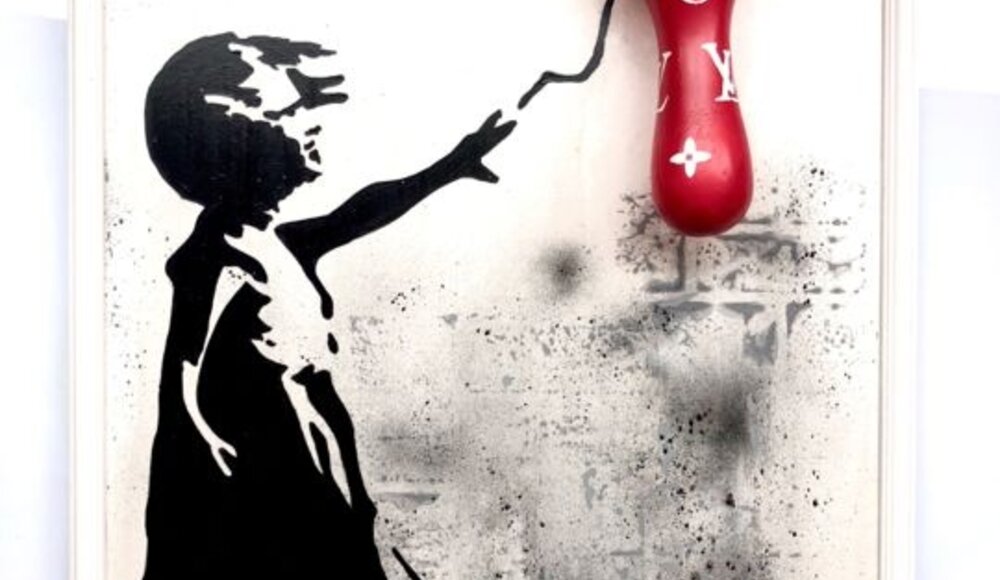

 Olimpia Gaia Martinelli
Olimpia Gaia Martinelli
